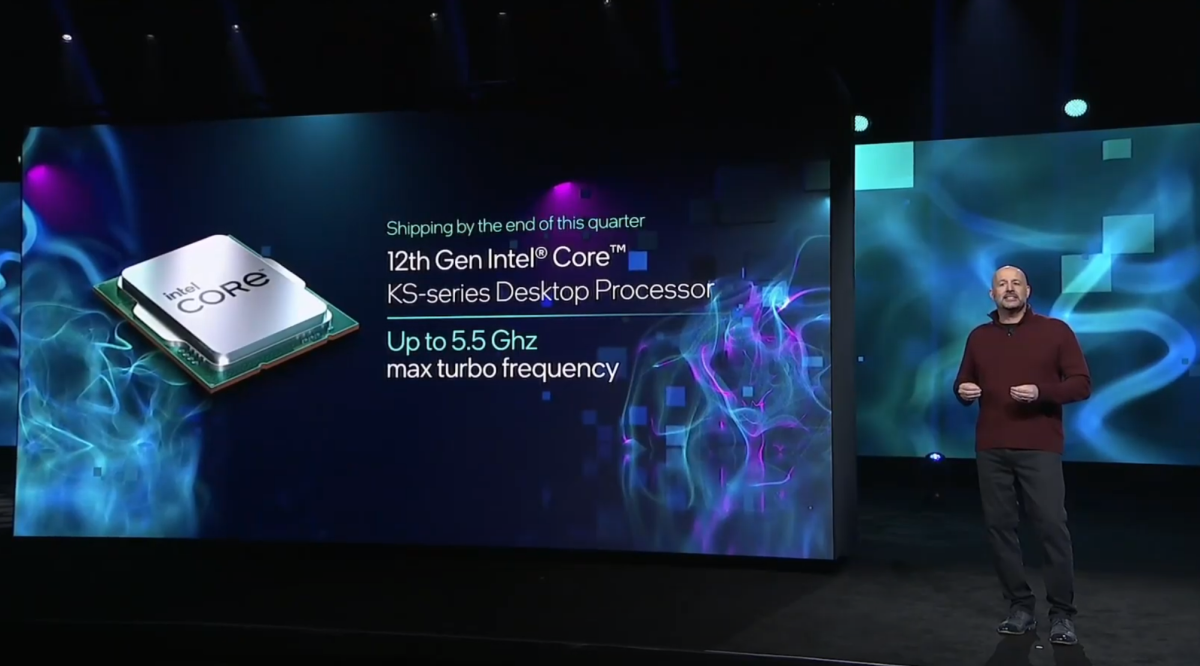 Image: Intel
Image: Intel
The 5GHz war between AMD and Intel is back in full force if this year’s CES is any indication.
As part of their “one more thing” teases, both companies demonstrated desktop CPUs running at 5GHz or greater. AMD’s started the rap battle by demoing its next-gen Ryzen 7000 processor running the game Halo Infinite with all of the CPU cores reportedly at 5GHz or above. Which CPU model and how many cores wasn’t disclosed, but we’re assuming at least 8-cores or more cores for it to be impressive.
Two hours later, Intel fired back with its own game demo of Hitman 3 being played on an upcoming 12th-gen Core i9 “KS” chip, with every performance core running at 5.2GHz. While impressive, Intel doesn’t technically qualify for the “all-core boost” prize since the remaining efficiency cores buzzed along at “only” 4GHz. But those performance cores are really what matters when it comes to gaming.
Why is 5GHz such a big deal: You
We know, you’re making the whatever face at all this chest puffing because it’s no big deal. After all, the original 5GHz line on a desktop PC was crossed with AMD’s FX-5950 chip almost nine years ago and no one cared back then either. So why does it matter this time?

Intel / YouTube
Intel / YouTube
Intel / YouTube
We’d mostly agree that breaking the 5GHz barrier isn’t quite the massive deal that AMD and Intel are making it out to be on a practical level when it comes to gaming, but increases in all-core clocks will also generally mean real performance gains for applications and tasks that use more cores. So if you run 3D modelling, lean into Adobe Premiere and Lightroom, or run advanced analysis using Microsoft Excel, the higher all-core boosts should net you decent gains of everywhere from 8 to 11 percent.
Still, the 5GHz breakthrough isn’t a game-changer until you consider its biggest advantage: Marketing. Slapping “5GHz” on a CPU box or PC works magic on consumers like nothing else. Yes, logically your brain tells you that 4.9GHz is basically the same as 5GHz, but emotionally that round number tickles all kinds of spots. Don’t believe us? Then why are things 99 cents instead of 1 dollar? Or new laptops listed for $2,499 and cars at $27,995? The obvious answer is that silly humans really respond to how we perceive numbers. And it works in every culture across the planet and likely through history. We’re sure the first barter ended up going for 19 chickens.
Robert Hallock, the director of technical marketing at AMD, broke down the concept during a recent CES 2022 interview on our Full Nerd podcast. (Jump to the 14:26 mark to hear his “5GHz” vs. “World’s best” thoughts, but really, watch the whole thing—Robert and AMD gaming architect Frank Azor dropped all sorts of interesting knowledge bombs on the show.)
“We done all sort of market research on what is sticking with people,” Hallock said. “When they see a letter, or a number, or a spec on the box, what moves the needle and what doesn’t? Big round whole numbers—like 4.0, 4.5, 5.0—that moves the needle quite a lot in consumer preference. But something like 5.1 or 5.2 barely registers on the Richter scale.”
So yes, the push for all-cores at 5GHz and higher is indeed significant, but mostly because big round numbers still work on humans. Fortunately, CPU makers have other ways to push the pedal to the metal with performance.
“Above [the stickiness of round numbers] is use-case relevance,” Hallock continued. “You’ve moved from specs to ‘is this good for me, and what I want to do?’ And so if you’re looking for the best CAD CPU, the best gaming, the best software development, the best compiling, that carries even more weight than a spec… And I think that over the last two or three years in particular, we’ve seen a decline on general market focus on frequency. I think people are realizing that (for example) Ryzen can come to the table at 4.6 or 4.7GHz and credibly beat a CPU that might be running at 5.1 to 5.2, and that’s a 500 to 600 megahertz spread, how do you reconcile that? And maybe the answer is that sometimes frequency doesn’t always matter.”
It’s in AMD’s interest to say that of course, as the company is pitching its upcoming Ryzen 7 5800X3D with radical new V-Cache technology as the “world’s best gaming CPU,” claiming that it topples Intel’s Core i9-12900K and even AMD’s own Ryzen 9 5900X despite a noticeable decrease in clock frequencies thanks to all that extra cache stacked on top of the chip. Squeezing ever-more performance out of these increasingly complex pieces of silicon isn’t as simple as just cranking up the clocks anymore, as Hallock explains in other portions of the interview.
But make no mistake: Faster chips are nothing but a good thing, no matter how that speed is achieved, and we’re looking forward to the 5GHz war brewing in 2022. Intel’s 12th-gen KS chip is scheduled to launch sometime this quarter, with Ryzen 7000 CPUs expected in the second half of the year. The Ryzen 7 5800X3D that AMD says will be the “world’s fastest gaming CPU” despite topping out at 4.5GHz boost clocks will be available this spring.
Author: Gordon Mah Ung, Executive Editor

One of founding fathers of hardcore tech reporting, Gordon has been covering PCs and components since 1998.
Recent stories by Gordon Mah Ung:
I’m not afraid of Qualcomm’s Snapdragon X ElitePC maker offers a potential fix for crashing Intel CPUsThe Full Nerd ep 248: Ryzen 9 7950X3D and the state of PC gaming




